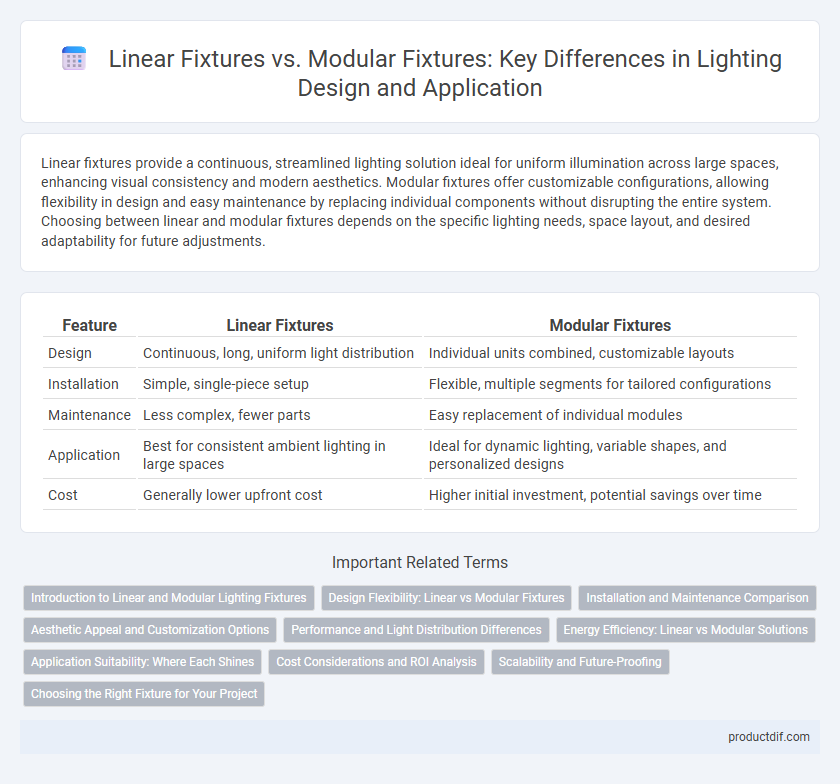Linear fixtures provide a continuous, streamlined lighting solution ideal for uniform illumination across large spaces, enhancing visual consistency and modern aesthetics. Modular fixtures offer customizable configurations, allowing flexibility in design and easy maintenance by replacing individual components without disrupting the entire system. Choosing between linear and modular fixtures depends on the specific lighting needs, space layout, and desired adaptability for future adjustments.
Table of Comparison
| Feature | Linear Fixtures | Modular Fixtures |
|---|---|---|
| Design | Continuous, long, uniform light distribution | Individual units combined, customizable layouts |
| Installation | Simple, single-piece setup | Flexible, multiple segments for tailored configurations |
| Maintenance | Less complex, fewer parts | Easy replacement of individual modules |
| Application | Best for consistent ambient lighting in large spaces | Ideal for dynamic lighting, variable shapes, and personalized designs |
| Cost | Generally lower upfront cost | Higher initial investment, potential savings over time |
Introduction to Linear and Modular Lighting Fixtures
Linear lighting fixtures provide continuous, sleek illumination ideal for modern architectural designs, offering flexibility in length and placement. Modular lighting fixtures consist of interchangeable components that allow customized configurations to suit diverse spaces and functional requirements. Both types enhance spatial aesthetics and lighting efficiency in commercial and residential environments.
Design Flexibility: Linear vs Modular Fixtures
Linear fixtures offer continuous, streamlined lighting ideal for long, narrow spaces, enhancing uniform illumination and creating sleek, minimalist designs. Modular fixtures provide customizable configurations, allowing designers to combine shapes and sizes for dynamic, adaptable lighting solutions tailored to specific spatial requirements. The choice between linear and modular fixtures significantly impacts architectural aesthetics and lighting efficiency in commercial and residential environments.
Installation and Maintenance Comparison
Linear fixtures offer straightforward installation with continuous runs that minimize wiring complexity, reducing labor time and costs. Modular fixtures enable flexible configurations and easier component replacement, which simplifies maintenance and reduces downtime. Both types require specific expertise, but modular systems often provide quicker access for repairs due to their segmented design.
Aesthetic Appeal and Customization Options
Linear fixtures offer sleek, continuous lines that enhance modern architectural designs, providing a streamlined aesthetic ideal for minimalist spaces. Modular fixtures deliver superior customization options with interchangeable components and varied shapes, allowing tailored lighting arrangements to fit diverse design themes. Both fixture types balance aesthetic appeal with functionality, but modular systems excel in adaptability for personalized lighting designs.
Performance and Light Distribution Differences
Linear fixtures typically offer uniform light distribution across long spans, ideal for general illumination in commercial and industrial spaces, while modular fixtures provide customizable configurations that allow for targeted lighting and enhanced control over light intensity. Performance-wise, linear fixtures are often simpler with consistent output, whereas modular fixtures incorporate advanced optics and dimming controls to optimize energy efficiency and adapt to specific lighting needs. The choice between them depends on the desired balance between broad, even coverage and flexible, high-performance lighting solutions tailored to complex environments.
Energy Efficiency: Linear vs Modular Solutions
Linear lighting fixtures typically offer superior energy efficiency by delivering consistent illumination with fewer components, reducing energy consumption and maintenance costs. Modular fixtures enable customizable configurations that optimize lighting levels for specific areas, minimizing wasted energy through targeted illumination. Choosing between linear and modular solutions depends on balancing energy-saving goals with lighting design flexibility in various applications.
Application Suitability: Where Each Shines
Linear fixtures excel in creating continuous, uniform lighting ideal for long hallways, retail displays, and office workspaces where consistent illumination enhances visibility and aesthetics. Modular fixtures offer customizable configurations suited for dynamic environments like conference rooms, galleries, and retail spaces requiring flexible lighting solutions to highlight specific areas or objects. Choosing between linear and modular fixtures depends on spatial layout, lighting needs, and design goals to optimize functionality and ambiance.
Cost Considerations and ROI Analysis
Linear fixtures typically offer a lower upfront cost due to simpler designs and standardized components, making them ideal for budget-conscious projects. Modular fixtures, while more expensive initially, provide enhanced flexibility and scalability, leading to better long-term ROI through reduced maintenance and adaptability to changing lighting needs. Analyzing total cost of ownership, including installation, energy efficiency, and lifespan, helps determine the most cost-effective solution for specific lighting applications.
Scalability and Future-Proofing
Linear fixtures offer seamless, continuous lighting ideal for expansive spaces, providing scalable solutions that easily extend by joining multiple units for consistent illumination. Modular fixtures enable customizable configurations with interchangeable components, allowing adaptable layouts to meet evolving design needs and simplify maintenance or upgrades. Both systems enhance future-proofing by supporting energy-efficient LED technology and smart controls, but modular fixtures excel in flexibility for dynamic environments requiring frequent reconfiguration.
Choosing the Right Fixture for Your Project
Linear fixtures provide continuous, uniform lighting ideal for long corridors and large open spaces, enhancing both visibility and aesthetics. Modular fixtures offer flexible configurations and easy customization, making them suitable for dynamic environments requiring frequent layout changes or targeted illumination. Selecting the right fixture depends on project scale, design requirements, and lighting control preferences to optimize performance and energy efficiency.
Linear fixtures vs Modular fixtures Infographic

 productdif.com
productdif.com